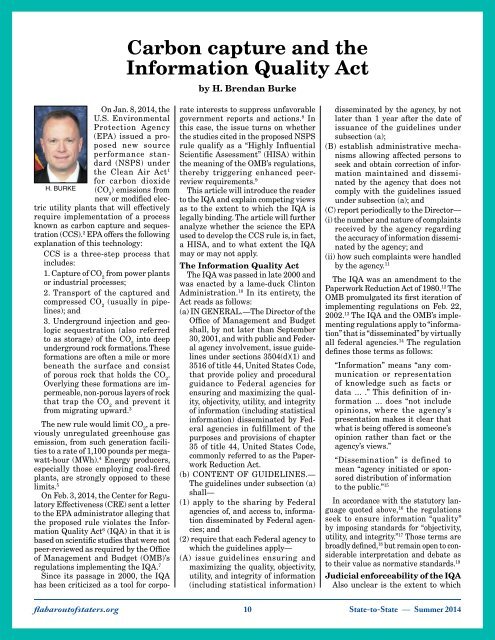OOS-2014-Summer-Final
OOS-2014-Summer-Final
OOS-2014-Summer-Final
Create successful ePaper yourself
Turn your PDF publications into a flip-book with our unique Google optimized e-Paper software.
Carbon capture and theInformation Quality Actby H. Brendan BurkeOn Jan. 8, <strong>2014</strong>, theU.S. EnvironmentalProtection Agency(EPA) issued a proposednew sourceperformance standard(NSPS) underthe Clean Air Act 1for carbon dioxideH. BURKE (CO 2) emissions fromnew or modified electricutility plants that will effectivelyrequire implementation of a processknown as carbon capture and sequestration(CCS). 2 EPA offers the followingexplanation of this technology:CCS is a three-step process thatincludes:1. Capture of CO 2from power plantsor industrial processes;2. Transport of the captured andcompressed CO 2(usually in pipelines);and3. Underground injection and geologicsequestration (also referredto as storage) of the CO 2into deepunderground rock formations. Theseformations are often a mile or morebeneath the surface and consistof porous rock that holds the CO 2.Overlying these formations are impermeable,non-porous layers of rockthat trap the CO 2and prevent itfrom migrating upward. 3The new rule would limit CO 2, a previouslyunregulated greenhouse gasemission, from such generation facilitiesto a rate of 1,100 pounds per megawatt-hour(MWh). 4 Energy producers,especially those employing coal-firedplants, are strongly opposed to theselimits. 5On Feb. 3, <strong>2014</strong>, the Center for RegulatoryEffectiveness (CRE) sent a letterto the EPA administrator alleging thatthe proposed rule violates the InformationQuality Act 6 (IQA) in that it isbased on scientific studies that were notpeer-reviewed as required by the Officeof Management and Budget (OMB)’sregulations implementing the IQA. 7Since its passage in 2000, the IQAhas been criticized as a tool for corporateinterests to suppress unfavorablegovernment reports and actions. 8 Inthis case, the issue turns on whetherthe studies cited in the proposed NSPSrule qualify as a “Highly InfluentialScientific Assessment” (HISA) withinthe meaning of the OMB’s regulations,thereby triggering enhanced peerreviewrequirements. 9This article will introduce the readerto the IQA and explain competing viewsas to the extent to which the IQA islegally binding. The article will furtheranalyze whether the science the EPAused to develop the CCS rule is, in fact,a HISA, and to what extent the IQAmay or may not apply.The Information Quality ActThe IQA was passed in late 2000 andwas enacted by a lame-duck ClintonAdministration. 10 In its entirety, theAct reads as follows:(a) IN GENERAL.—The Director of theOffice of Management and Budgetshall, by not later than September30, 2001, and with public and Federalagency involvement, issue guidelinesunder sections 3504(d)(1) and3516 of title 44, United States Code,that provide policy and proceduralguidance to Federal agencies forensuring and maximizing the quality,objectivity, utility, and integrityof information (including statisticalinformation) disseminated by Federalagencies in fulfillment of thepurposes and provisions of chapter35 of title 44, United States Code,commonly referred to as the PaperworkReduction Act.(b) CONTENT OF GUIDELINES.—The guidelines under subsection (a)shall—(1) apply to the sharing by Federalagencies of, and access to, informationdisseminated by Federal agencies;and(2) require that each Federal agency towhich the guidelines apply—(A) issue guidelines ensuring andmaximizing the quality, objectivity,utility, and integrity of information(including statistical information)disseminated by the agency, by notlater than 1 year after the date ofissuance of the guidelines undersubsection (a);(B) establish administrative mechanismsallowing affected persons toseek and obtain correction of informationmaintained and disseminatedby the agency that does notcomply with the guidelines issuedunder subsection (a); and(C) report periodically to the Director—(i) the number and nature of complaintsreceived by the agency regardingthe accuracy of information disseminatedby the agency; and(ii) how such complaints were handledby the agency. 11The IQA was an amendment to thePaperwork Reduction Act of 1980. 12 TheOMB promulgated its first iteration ofimplementing regulations on Feb. 22,2002. 13 The IQA and the OMB’s implementingregulations apply to “information”that is “disseminated” by virtuallyall federal agencies. 14 The regulationdefines those terms as follows:“Information” means “any communicationor representationof knowledge such as facts ordata ... .” This definition of information... does “not includeopinions, where the agency’spresentation makes it clear thatwhat is being offered is someone’sopinion rather than fact or theagency’s views.”“Dissemination” is defined tomean “agency initiated or sponsoreddistribution of informationto the public.” 15In accordance with the statutory languagequoted above, 16 the regulationsseek to ensure information “quality”by imposing standards for “objectivity,utility, and integrity.” 17 Those terms arebroadly defined, 18 but remain open to considerableinterpretation and debate asto their value as normative standards. 19Judicial enforceability of the IQAAlso unclear is the extent to whichflabaroutofstaters.org 10 State-to-State — <strong>Summer</strong> <strong>2014</strong>


